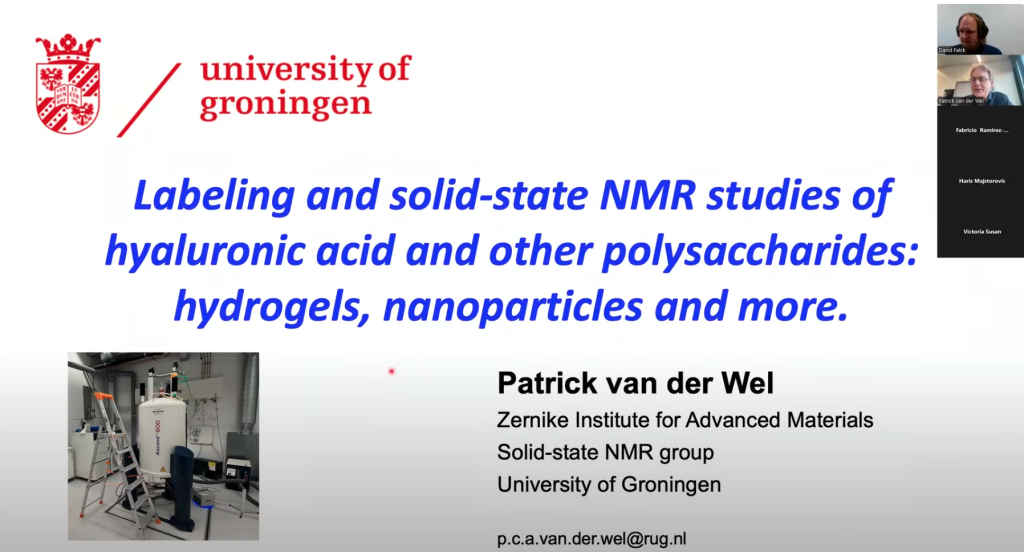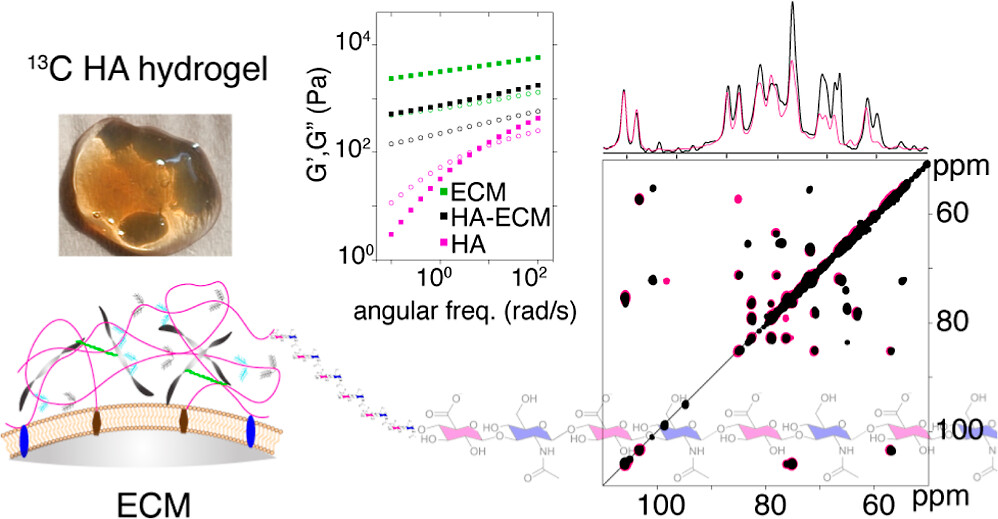Tag: hyaluronic acid
Webinar: GlycoScience Webinar on polysaccharide ssNMR research
On 27 March Patrick gave an online presentation in the EGC webinar series, on the topic of using solid-state NMR (and isotope labeling) to study polysaccharides in various contexts. The title of the presentation was: “Labeling and solid-state NMR studies of hyaluronic acid and other polysaccharides: hydrogels, nanoparticles and more”
EGC Webinar #86 Glycochemistry (March 27, 4 pm CET)
Patrick van der Wel (Zernike Institute for Advanced Materials, University of Groningen, the Netherlands)
“Labeling and solid-state NMR studies of hyaluronic acid and other polysaccharides: hydrogels, nanoparticles and more”
A recording of the lecture is visible via YouTube. In the presentation he referred to several published stories, that you can access via our publications list page.

Publication: NMR of 13C-labeled hyaluronic acid hydrogels (in context of ECM)

Congratulations to PhD student Pushpa Rampratap (and her co-authors!) on the publication of a new paper on the use of solid-state NMR spectroscopy to study hydrogels that mimic aspects of the extracellular matrix (ECM). Building on her previously published approach to produce 13C labeled hyaluronic acid (HA; with very high molecular weights), she performed extensive series of magic-angle-spinning NMR analyses of HA hydrogels under various conditions. Notably, this included ECM-mimicking conditions that are commonly used in cell culture and biomedical engineering studies (using the Geltrex ECM extract).
The resulting (very nice) paper shows the power of combining 13C enrichment with modern MAS NMR to gain truly atomic-level insights into the behavior of complex hydrogels (or ECMs). Surprisingly (to us), we observed highly localized changes affecting specific atoms in the HA, with the affected atoms being different from what we had expected. We briefly discuss the implications of this finding for e.g. HA-interacting proteins in a biological context. That said, these methods should be particularly powerful also for studying engeneering HA-based hydrogels and nanoparticles, which are finding widespread uses in different types of industries.
Citation:
Rampratap et al. (2024) Resolving Atomic-Level Dynamics and Interactions of High-Molecular-Weight Hyaluronic Acid by Multidimensional Solid-State NMR ACS Appl. Mater. Interfaces 2024, 16, 33, 43317–43328

Publication: 13C labeling of hyaluronic acid polysaccharides (for ssNMR analysis)
Congrats to Pushpa and her collaborators on the new paper in the journal Carbohydrate Polymers. This new report describes Pushpa’s work to achieve the production of high-molecular-weight (HMW) hyaluronic acid, as part of her PhyCan (physics of cancer) project. Our interest in this polysaccharide stems from its important role in the extracellular matrix (ECM) of tissues, and in particular certain types of cancer tissues. In such tumors the amount of HA is upregulated, seemingly contributing to the progression of cancer development. A challenge in understanding this process is that HMW is difficult to study with most structural techniques, as it can be very large (megadaltons!) and highly dynamic. In this project, Pushpa outfitted HMW HA with 13C (and 15N) isotope labels, and shows that this makes multidimensional NMR (including solid-state NMR) feasible. This approach is expected to be valuable for many research areas, as HA is also important for many biomedical engineering (BME) type applications. ECM-mimicking hydrogels are for instance of great interest for engineering 3D environments for growing cells.
Publication:
Rampratap P, Lasorsa A, Perrone B, Van Der Wel PCA, Walvoort MTC. Production of isotopically enriched high molecular weight hyaluronic acid and characterization by solid-state NMR. Carbohydrate Polymers. 2023 Sep;316:121063.